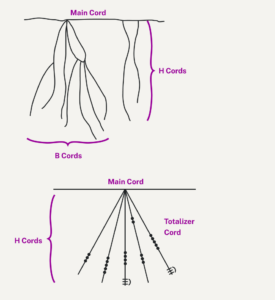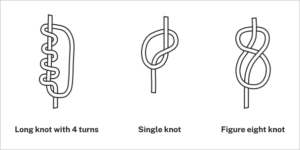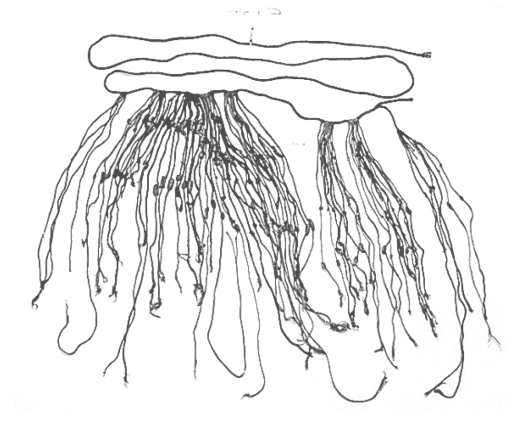The Inca Counting System Cont.
The Quipu

The counting board was good for doing quick computations, but it did not provide a good way to keep a permanent recording of quantities or computations. For this purpose, they used the quipu. The quipu is a collection of cords with knots in them.
There were various purposes for the quipu. Some believe that they were used to keep an account of their traditions and history, using knots to record history rather than some other formal system of writing. One writer has even suggested that the quipu replaced writing as it formed a role in the Incan postal system.[1] Another proposed use of the quipu is as a translation tool. After the conquest of the Incas by the Spaniards and subsequent “conversion” to Catholicism, an Inca supposedly could use the quipu to confess their sins to a priest. Yet another proposed use of the quipu was to record numbers related to magic and astronomy, although this is not a widely accepted interpretation.
The cords and knots of a quipu are carefully arranged so that the position and type of cord or knot give specific information on how to decipher the cord. A quipu is made up of a main cord which has other cords (branches) tied to it as seen in the picture to the right.[2]
Locke called the branches [latex]H[/latex] cords. They are attached to the main cord. [latex]B[/latex] cords, in turn, were attached to the [latex]H[/latex] cords. Most of these cords would have knots on them. Rarely are knots found on the main cord, however, and tend to be mainly on the [latex]H[/latex] and [latex]B[/latex] cords. A quipu might also have a “totalizer” cord that summarizes all of the information on the cord group in one place.
Locke points out that there are three types of knots, each representing a different value, depending on the kind of knot used and its position on the cord. The Incas, like us, had a decimal (base-ten) system, so each kind of knot had a specific decimal value.
- The Single knot, pictured in the middle of figure 2[3] was used to denote tens, hundreds, thousands, and ten thousands. They would be on the upper levels of the [latex]H[/latex] cords.
- The figure-eight knot on the end was used to denote the integer “one.”
- Every other integer from [latex]2[/latex] to [latex]9[/latex] was represented with a long knot, shown on the left of the figure. (Sometimes long knots were used to represents tens and hundreds.) Note that the long knot has several turns in it – the number of turns indicates which integer is being represented. The units (ones) were placed closest to the bottom of the cord, then tens right above them, then the hundreds, and so on.

quipu
Quipus were ancient recording devices made of knotted cords, used by the Incas for keeping records. The cords featured knots in hierarchical numerical positions, representing different values within a base-ten decimal system. This system included single knots for tens and higher values, figure-eight knots for ones, and long knots for integers between two and nine.
How to: Read a Quipu
- Identify the Cords: Notice the primary cord and its attached branch cords. The branch cords are classified into [latex]H[/latex] (hierarchal) and [latex]B[/latex] (base) cords.
- Interpret the Knots: Observe the knots along the cords. Single knots indicate units of tens, hundreds, or thousands, typically positioned on the [latex]H[/latex] cords’ upper levels. Figure-eight knots represent the value one, while long knots correspond to numbers from two to nine.
- Decipher the Hierarchy: Start from the bottom of a cord, reading the knots in ascending order: the lower knots represent ones, followed by tens, hundreds, and so on up the cord.
- Summarize the Data: Compile the values from the knots to understand the total number represented on each B cord, and aggregate this information to decode the complete message of the quipu.
In order to make reading these pictures easier, we will adopt a convention that is consistent.
- For the long knot with turns in it (representing the numbers [latex]2[/latex] through [latex]9[/latex]), we will use the following notation:
 The four horizontal bars represent four turns and the curved arc on the right links the four turns together. This would represent the number [latex]4[/latex].
The four horizontal bars represent four turns and the curved arc on the right links the four turns together. This would represent the number [latex]4[/latex]. - We will represent the single knot with a large dot ( [latex]\cdot[/latex] ).
- We will represent the figure eight knot with a sideways eight ( [latex]\infty[/latex] ).
The colors of the cords had meaning and could distinguish one object from another. One color could represent llamas, while a different color might represent sheep, for example. When all the colors available were exhausted, they would have to be re-used. Because of this, the ability to read the quipu became a complicated task and specially trained individuals did this job. They were called Quipucamayoc, which means keeper of the quipus. They would build, guard, and decipher quipus.
As you can see from this photograph of an actual quipu below, they could get quite complex.

- Diana, Lind Mae; The Peruvian Quipu in Mathematics Teacher, Issue 60 (Oct., 1967), p. 623–28. ↵
- Diana, Lind Mae; The Peruvian Quipu in Mathematics Teacher, Issue 60 (Oct., 1967), p. 623–28. ↵
- "https://web.archive.org/web/20020606031947/http://wiscinfo.doit.wisc.edu/chaysimire/titulo2/khipus/what.htm" ↵